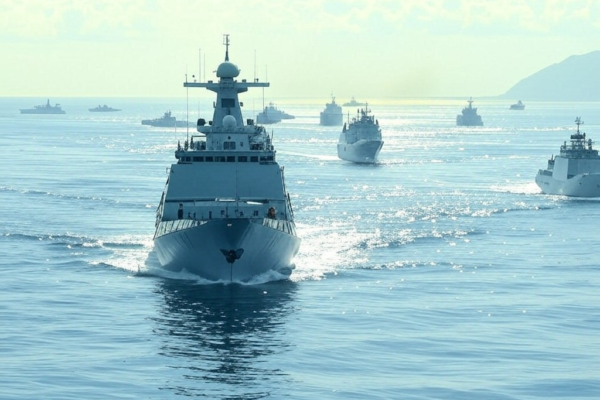
China’s Largest Military Exercise Near Taiwan in 28 Years: What’s Different?
This story was originally published on the website of CommonWealth Magazine and is reprinted with permission The Chinese military conducted exercises again, but this time, it felt notably different. Between December 9 and 11, China designated seven reserved airspaces east of Zhejiang and Fujian. In response, Taiwan’s Ministry of National Defense (MND) immediately announced the establishment of a response center and activated its preparedness drills on December 9. “This was the largest-scale activity around Taiwan since the 1996 Taiwan Strait Crisis,” said MND spokesperson Sun Li-fang. However, unlike the previous Joint Sword A and B exercises that were highly publicized, China did not issue any official announcements regarding these drills, despite Taiwan’s heightened military alert. “This wasn’t exactly a military drill,” emphasized MND Deputy Chief of Staff for Intelligence Hsieh Jih-sheng, “But, announced or not, the scale of vessels dispatched this time was staggering, with their range extending from the first to the second island chain.” The only solid figures made available to the public came from senior national security officials who disclosed to Reuters that China had deployed nearly 90 naval and coast guard vessels around Taiwan, as well as in the East and South China Seas, two-thirds of which were warships. Despite the large deployment, Taiwan’s MND reported that the cumulative number of Chinese aircraft and vessels over the two-day period did not surpass single-day records set in September and October of 2024. Adding to the ambiguity, the MND did not disclose the exact positions and deployments of Chinese ships or coast guard vessels. Observers speculated that China’s recent actions were likely in response to President Lai Ching-te’s return from diplomatic visits to Taiwan’s allies. However, military experts argued that Taiwan’s heightened state of alert looked more like a proactive “preventive deterrence” strategy. Did Taiwan’s Preventive Action Diminish China’s Threat? “The political timing of these exercises seemed off,” observed Ou Si-fu, Director of the Chinese Politics, Military, and Operational Concepts Research Division at Taiwan’s Institute for National Defense and Security Research. From a broader perspective, Nick Marro, Global Trade Lead Analyst at the Economist Intelligence Unit (EIU), noted that China was focused on diplomatic repair and dealing with renewed trade tensions with the United States, making a large-scale invasion of Taiwan or military drill unlikely in the short term. Additionally, both the Cross-Strait Entrepreneurs Summit and the Twin-City Forum had taken place recently. More significantly, Trump and Xi Jinping had just spoken on the phone, making an escalation in the Taiwan Strait immediately afterward unlikely. Moreover, the timing was not favorable for major military exercises. Historically, China conducted real-combat drills in July and August as part of its annual training cycle. After mid-autumn, the Taiwan Strait would become more treacherous, unsuitable for large-scale operations, and China typically entered a review and assessment phase at the year-end. “The Chinese military tended to be quieter in December. With the sea conditions being poor, I was certain several navy and coast guard personnel were experiencing seasickness,” quipped Christopher Sharman, Director of the China Maritime Studies Institute at the U.S. Naval War College. According to Taiwan’s MND, there had been no live-fire activity or flight bans reported within the seven reserved airspaces announced by China. Furthermore, these reserved zones stretched from Zhejiang to Fujian. “These areas looked more like they were isolating China itself rather than Taiwan,” remarked Drew Thompson, Senior Fellow at the S. Rajaratnam School of International Studies at Nanyang Technological University and a former U.S. defense official. Still, Taiwan’s heightened alert highlighted a crucial trend: the key force behind China’s intimidation of Taiwan—the Chinese Navy—had already significantly expanded over the past two years. The Real Risk is Complacency “Extensive Chinese military activity in the Western Pacific was no longer news,” said Drew Thompson. “Let’s not forget that China now has the world’s largest navy.” “Without position data or an official PLA statement, this event remained difficult to interpret. However, China had already demonstrated its capability to maintain a persistent presence around Taiwan, Japan, the Philippines, and the South China Sea,” he added. Sharman further warned that China’s military actions did not always require naming, but over the past two years, the PLA had normalized airspace intrusions in the Taiwan Strait and steadily increased naval deployments around Taiwan. This trend risked desensitizing observers, allowing China to mask real operations under routine exercises. Nick Marro also observed that Taiwan’s stock and currency markets were unaffected by previous military exercises. “One could say markets had stabilized, and people were no longer afraid. However, the flip side was that complacency may have been setting in, which is the greatest risk.”


